Summary Overview
Cocoa Market Overview:
The global cocoa market is experiencing steady growth, driven by increasing demand in the food and beverage industry, particularly for chocolate products. The market encompasses various forms of cocoa, including cocoa beans, cocoa powder, cocoa butter, and chocolate. This report provides an in-depth analysis of procurement trends, with a focus on cost optimization strategies and the role of digital tools in improving procurement and manufacturing processes.
Key challenges in cocoa procurement include managing fluctuations in raw material prices, ensuring sustainable farming practices, and addressing environmental concerns such as deforestation. Digital procurement tools and strategic sourcing are essential for optimizing the cocoa supply chain and enhancing long-term competitiveness. With rising global demand, market intelligence is being used to enhance efficiency and mitigate risks in the cocoa industry.
The cocoa market is expected to continue growing steadily through 2032, with the following key highlights:
-
Market Size: The global cocoa market is projected to reach USD 26.20 billion by 2032, growing at a CAGR of approximately 7.30 % from 2024 to 2032.
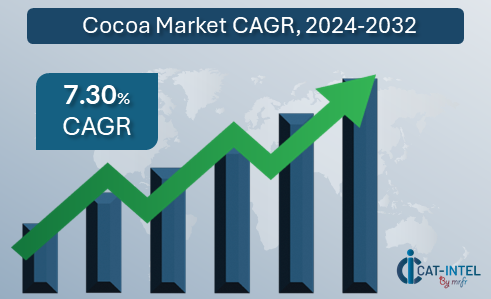
-
Sector Contributions: Growth in the cocoa market is driven by: -
Demand in the Food & Beverage Industry: Increased consumption of chocolate and confectionery products, especially in emerging markets, is driving cocoa demand. -
Health Trends: Growing popularity of dark chocolate and its perceived health benefits, particularly in antioxidants, is fuelling market growth. -
Sustainability Efforts: The rise in demand for ethically sourced and Fair Trade certified cocoa is influencing procurement strategies. -
Investment in Agricultural Advancements: Increased focus on improving cocoa yield through better farming practices and research in pest-resistant cocoa varieties. -
Regional Insights: North America plays a significant role in the global cocoa market, both as a major consumer and as a key player in the value-added cocoa products sector.
Key Trends and Sustainability Outlook:
-
Digital Integration: Automation in cocoa farming, processing, and distribution is enhancing efficiency, reducing waste, and optimizing supply chains. -
Sustainability Focus: The industry is seeing a shift towards sustainable and traceable cocoa sourcing, with a focus on reducing deforestation, enhancing farmer livelihoods, and promoting environmental stewardship. -
Innovative Products: Growing demand for premium and organic cocoa products, including specialty chocolates, is driving the development of new products. -
Data-Driven Procurement: The use of big data and predictive analytics in cocoa procurement is helping to forecast trends, monitor market conditions, and ensure supply chain resilience.
Growth Drivers:
-
Consumer Preferences: Increasing demand for high-quality chocolate products and greater consumer interest in ethical sourcing and sustainability are major drivers. -
Global Expansion: The rise of emerging markets, particularly in Asia-Pacific, is expanding cocoa consumption. -
Health and Wellness Trends: As consumers seek healthier alternatives, dark chocolate, with its perceived health benefits, continues to drive cocoa consumption. -
Sustainability Regulations: Pressure from governments and international organizations is encouraging the use of sustainable cocoa farming practices and ensuring compliance with global standards. -
Innovation in Cocoa Products: The demand for gourmet, organic, and functional chocolate products tailored to niche markets is accelerating cocoa innovation.
Overview of Market Intelligence Services for the Cocoa Market:
Recent market reports have identified significant challenges, such as price volatility of cocoa beans and the need for ethical sourcing practices. Market intelligence services provide actionable insights that help companies identify cost-saving opportunities, optimize supplier management, and enhance the resilience of the cocoa supply chain. These reports also assist businesses in maintaining compliance with sustainability standards and improving procurement efficiency.
Procurement Intelligence for Cocoa: Category Management and Strategic Sourcing:
To remain competitive in the cocoa market, companies are enhancing procurement strategies by leveraging spend analysis and improving supplier management. Effective category management and strategic sourcing are crucial to minimizing procurement costs and ensuring a consistent supply of high-quality cocoa. By utilizing market intelligence, companies can streamline procurement processes and secure favourable contracts, ensuring long-term sustainability in the cocoa supply chain.
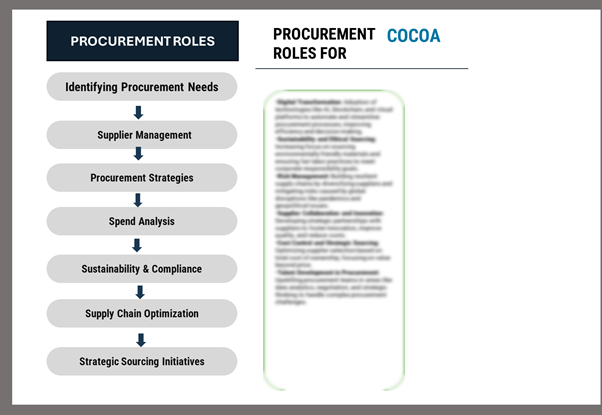
Pricing Outlook for Cocoa: Spend Analysis
The pricing outlook for cocoa is expected to remain stable over the long term, although there may be periodic fluctuations influenced by several key factors. Variations in raw material costs, such as cocoa bean prices, changes in climate conditions, and shifts in global supply and demand, can significantly affect price trends. Additionally, fluctuations in transportation costs, labor expenses, and regulatory requirements related to sustainability practices are contributing to price dynamics in the cocoa market.
Graph shows general upward trend pricing for cocoa and growing demand. However, there may be fluctuations influenced by economic conditions, technological advancements, and competitive dynamic.
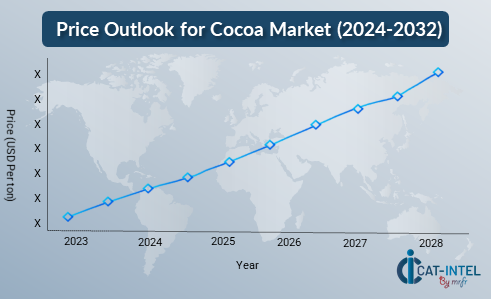
Efforts to enhance operational efficiency, improve the sustainability of cocoa farming, and streamline the supply chain through digital platforms will be vital for managing costs. Adopting new farming technologies, improving cocoa yield, and investing in sustainable practices can help mitigate some of these pricing pressures.
Collaboration between farmers, cocoa processors, and manufacturers, as well as optimizing sourcing and procurement strategies, are essential in managing costs. Despite challenges in raw material pricing and supply chain complexities, focusing on sustainability, traceability, and technological innovation will be critical for managing pricing fluctuations effectively.
Cost Breakdown for Cocoa: Total Cost of Ownership (TCO) and Cost-Saving Opportunities
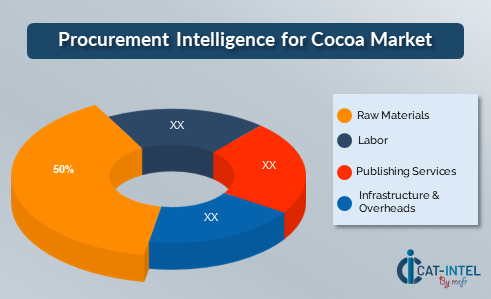
- Raw Materials (50%)
- Description: Investments include sourcing cocoa beans, maintaining quality control, and ensuring traceability and sustainability in the supply chain. These costs are driven by the volatility of global cocoa prices, especially in key producing regions like West Africa and Latin America.
- Trends: Rising demand for sustainably sourced and Fair-Trade certified cocoa, increasing adoption of precision farming techniques, and efforts to improve cocoa bean quality and yields.
- Labor (XX%)
- Publishing Services (XX%)
- Infrastructure & Overheads (XX%)
Cost-Saving Opportunities: Negotiation Levers and Purchasing Strategies
In the cocoa industry, optimizing procurement processes and improving supply chain management can lead to significant cost savings and enhanced service delivery. Establishing long-term partnerships with cocoa farmers, suppliers, and manufacturers can help secure competitive pricing, reduce costs, and enhance operational efficiency. Collaborative relationships with cocoa producers and processing companies can offer benefits such as flexible payment terms, reliable supply, and cost-effective sourcing solutions.
Investing in sustainable farming practices, improving traceability systems, and leveraging technology in the supply chain can reduce costs, improve product quality, and streamline operations. Additionally, implementing logistics and transportation optimization strategies can further reduce overheads related to infrastructure. Multi-sourcing strategies, including diversifying supply channels and negotiating long-term contracts with competitive terms, can help mitigate risks related to supply chain disruptions and strengthen negotiation power.
Supply and Demand Overview for Cocoa: Demand-Supply Dynamics and Buyer Intelligence for Effective Supplier Relationship Management (SRM)
The global cocoa market is experiencing steady growth, driven by strong demand from industries such as chocolate production, pharmaceuticals, and food and beverages. The balance between supply and demand is shaped by factors like changes in consumer preferences, technological advancements, and climate conditions affecting crop yields.
Demand Factors:
-
Consumer Preferences: Increasing demand for premium, ethically sourced, and organic cocoa is driving the need for high-quality cocoa beans. -
Sustainability Trends: Rising consumer demand for sustainable and Fair-Trade certified cocoa is shaping procurement strategies. -
Technological Integration: The cocoa industry is adopting digital tools to enhance supply chain visibility, improve traceability, and reduce inefficiencies. -
Global Growth in Chocolate Consumption: Rising demand for chocolate, particularly in emerging markets, is increasing the need for reliable cocoa sourcing.
Supply Factors:
-
Cocoa Bean Availability: The availability of quality cocoa beans is impacted by climate conditions and geographical factors, particularly in key producing regions like West Africa and Latin America. -
Sustainability Practices: An increasing focus on sustainable farming practices, certifications, and responsible sourcing is shaping supply chain dynamics. -
Technological Advancements: Innovations in farming techniques, cocoa processing, and product development are improving the efficiency and quality of cocoa production. -
Supplier Competition: Intense competition among cocoa producers is leading to improvements in product quality, supply chain reliability, and pricing, benefiting buyers.
Regional Demand-Supply Outlook: Cocoa
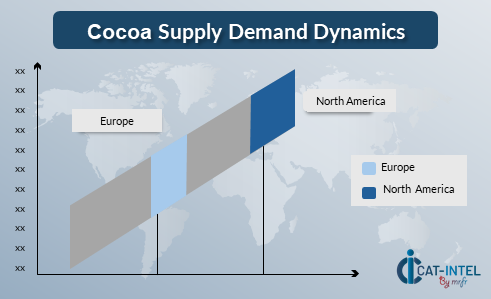
The Image shows growing demand for cocoa in both North America and Europe with potential price increases and increased Competition.
North America: Dominance in Cocoa Consumption
North America plays a particularly the United States and Canada, leading role in the global cocoa market, driven by several key factors:
-
Consumer Demand: The region has a strong demand for chocolate and other cocoa-based products, particularly in the confectionery and snack sectors. -
Sustainability Focus: There is an increasing demand for ethically sourced and sustainable cocoa, prompting North American companies to adopt Fair Trade and Rainforest Alliance certifications. -
Technological Integration: North America is a leader in adopting new cocoa processing technologies and digital tools to improve supply chain transparency and operational efficiency. -
Market Size and Growth: The North American market represents one of the largest consumers of cocoa, with continuous growth driven by both traditional markets and new trends like plant-based and organic products.
North America Remains a key hub cocoa price drivers Innovation and Growth.
Supplier Landscape: Supplier Negotiations and Strategies
The supplier landscape in the cocoa market is highly competitive, with a blend of large multinational cocoa producers and smaller, specialized suppliers catering to niche market needs. These suppliers significantly impact key market elements such as pricing, product quality, and supply chain reliability. The cocoa market includes major players with extensive global networks alongside smaller suppliers focused on organic, sustainable, and Fair Trade-certified cocoa.
In regions with high demand for cocoa, such as North America and Europe, the supplier landscape is diverse, with both well-established players and emerging providers meeting local and global needs. As consumer demand for ethically sourced, high-quality cocoa continues to grow, suppliers are focusing on improving sustainability practices, enhancing cocoa bean quality, and forming strategic partnerships to strengthen their market positions. Additionally, there is an increasing emphasis on compliance with environmental standards, certifications, and traceability, pushing suppliers to refine their offerings to meet evolving industry requirements.
Key Suppliers in the Cocoa Market Include:
- Olam Group
- Cargill
- Barry Callebaut
- Nestlé Cocoa Plan
- The Hershey Company
- ADM (Archer Daniels Midland)
- Cocoa Processing Company
- Bunge Loder’s Croklaan
- Ecom Agro-industrial
- Sambavan Cocoa

Key Developments Procurement Category Significant Development:
Significant Development |
Description |
Market Growth |
The global cocoa market is expanding, fueled by increasing demand for chocolate, specialty cocoa products, and the growth of the confectionery, beverage, and food industries. |
Sustainable Practices |
Rising demand for sustainably sourced cocoa, focusing on ethical farming practices, certification programs (e.g., Fair Trade), and reducing environmental impacts across the supply chain. |
Service Diversification |
Expansion of cocoa products, including specialty cocoa types, organic and traceable beans, as well as by-products like cocoa butter, to meet diverse industry needs. |
Technological Innovations |
Implementation of advanced farming techniques, precision agriculture, and blockchain technology to improve traceability, quality control, and supply chain transparency in cocoa production. |
E-commerce Expansion |
Increasing digital platforms in the cocoa sector, including direct-to-consumer models for chocolate products, enabling farmers and manufacturers to reach broader markets efficiently. |
Focus on Efficiency |
Enhanced focus on optimizing cocoa supply chains, improving harvesting processes, reducing waste, and streamlining the logistics of cocoa bean transport to meet growing global demand. |
Cocoa Industry Attribute/Metric |
Details |
Cocoa Market Sizing |
The global cocoa market is projected to reach USD 26.20 billion by 2032, growing at a CAGR of approximately 7.30 % from 2024 to 2032. |
Technology Adoption Rate in Cocoa |
Approximately 30% of cocoa producers are adopting advanced farming technologies, such as precision agriculture, blockchain for traceability, and AI for improving crop yields and quality control. |
Top Cocoa Industry Strategies for 2024 |
Focus on sustainable cocoa sourcing, implementing traceability systems, increasing investment in organic cocoa production, and enhancing supply chain efficiency to meet global demand. |
Cocoa Supply Chain Automation |
20% of cocoa companies are automating key processes such as bean grading, sorting, and logistics to improve efficiency, reduce waste, and enhance product consistency. |
Cocoa Industry Challenges |
Key challenges include addressing supply chain disruptions, managing climate-related risks, ensuring fair wages and ethical sourcing, and adapting to fluctuating global cocoa prices. |
Key Cocoa Suppliers |
Leading suppliers in the cocoa industry include Olam Group, Cargill, Barry Callebaut, Nestlé, and Mars, providing a range of products from cocoa beans to finished cocoa products. |
Key Regions Covered |
West Africa, Latin America, and Southeast Asia are major cocoa-producing regions, while North America and Europe are significant consumers of cocoa products. |
Market Drivers and Trends |
Market growth is driven by the increasing demand for chocolate, the rise in premium and ethical cocoa products, innovations in cocoa farming, and growing consumer interest in sustainability and ethical sourcing. |

